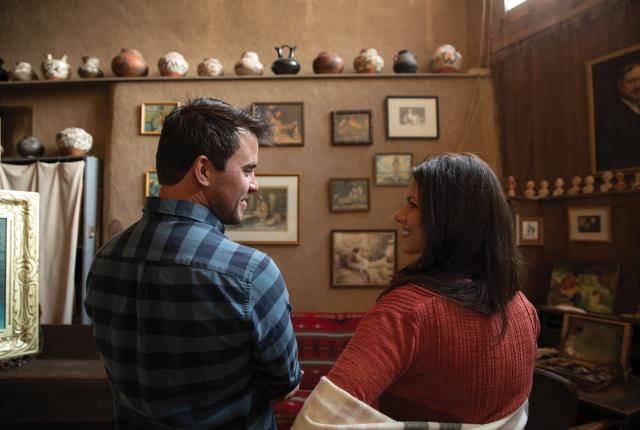DAVISON KOENIG, EXECUTIVE DIRECTOR of the Couse-Sharp Historic Site, describes Taos as “an unlikely cauldron of creativity.” On the surface, it seems unlikely that a town of barely 6,000 more than 50 miles from a major urban area would become one of the most respected art communities in the world. But many influential artists call Taos home.
Master potter Angie Yazzie works with clay found in sacred places around Taos Pueblo. Gustavo Victor Goler carves intricate Catholic saints, or santos, out of wood. Sasha Raphael vom Dorp creates images of light and sound from a nose cowling of a 727 jet.
Dig into the town’s history, and it’s clear this abundance of talent is nothing new. Taos Pueblo began more than 1,000 years ago as a vital trading hub for the region’s Native groups, and later for trappers descending from the Rocky Mountains. Commercial trade led to intellectual trade, Koenig points out. So when Anglo artists like E.I. Couse and J.H. Sharp arrived in the early 1900s, “they walked into this duality of a community steeped in tradition, but also open to outsiders and ideas.” They found a home away from the East Coast’s more codified art world, where they could experiment with their crafts and cultivate what became the Taos Society of Artists.
The town’s artistic tradition continues today through the Couse-Sharp Historic Site’s new $3.5 million Lunder Research Center, as well as through collections at the Millicent Rogers Museum, Harwood Museum of Art, Taos Art Museum, and more than 60 galleries. “Not only have we inherited a rich, diverse cultural scene,” Koenig says. “We’ve built upon it.”
Home grown
Taos native Luís Barela has woodcarving in his blood. The grandson of carver Patrociño Barela, he’s learned to take cues from the light and dark of the cedar wood grain—pieces he selects with purpose from the land around his home. “The Taos mountains have something special in them,” he says. For studio visits, call 505-758-7966.


